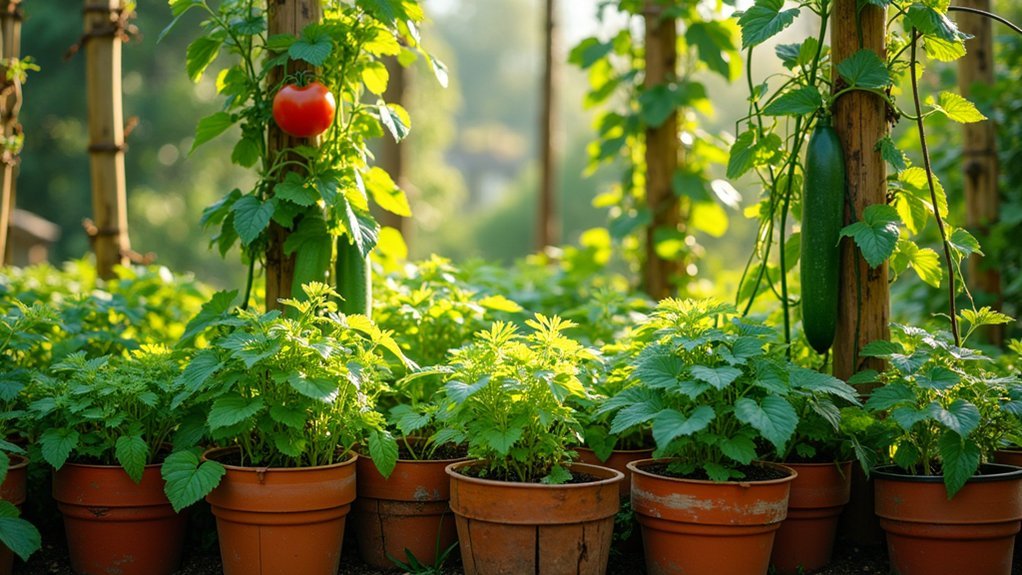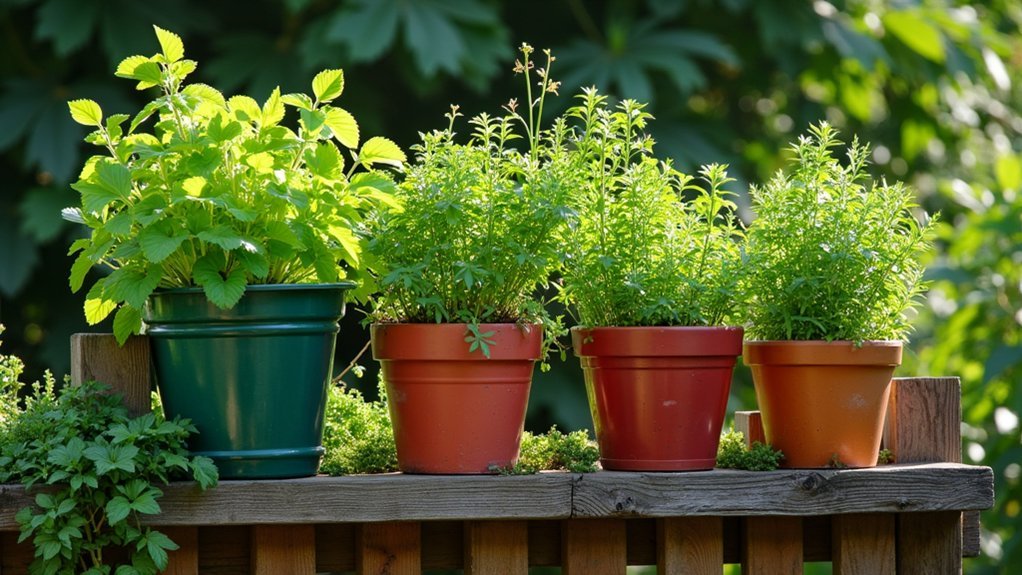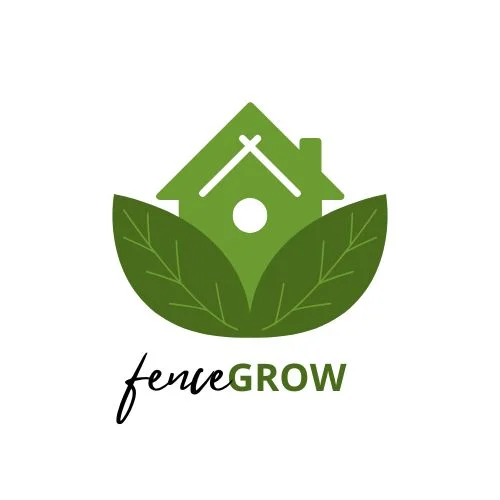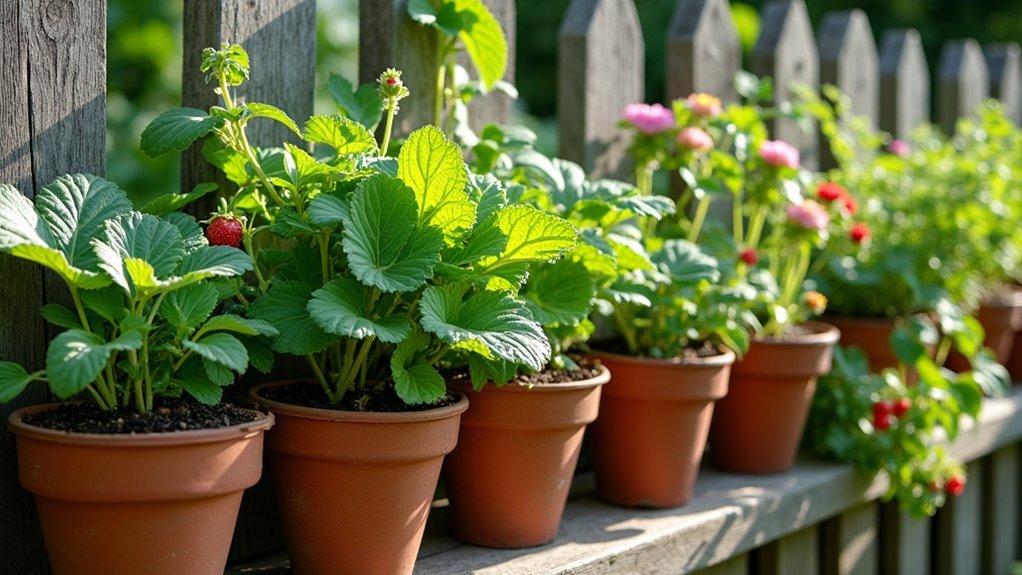For successful edible container fence gardening, arrange plants using the thriller-filler-spiller method with tall edibles as focal points. Choose compatible climbing varieties like Malabar spinach or blackberries with appropriate supports installed early. Use drip irrigation systems and quality potting mix for peak growth. Position containers to guarantee 6-8 hours of sunlight and easy harvest access. Place taller plants strategically to avoid shading smaller ones. These foundational techniques will transform your fence into a productive vertical garden.
Master the Thriller-Filler-Spiller Method for Fence Container Design

Three key elements form the backbone of successful fence container gardening.
Start by positioning your “thriller” plants—tall, striking edibles like rosemary or peppers—centrally in containers viewed from all angles or at the back when viewed from one side. These vertical growers provide height and structure.
Create vertical drama with “thriller” plants as your container’s focal point—they’re the backbone that draws the eye upward.
Next, add “filler” plants such as lettuce, kale, or bush beans around your thriller. These mid-sized, bushy edibles create texture and density while maximizing your harvest potential. Combine 2-3 compatible varieties for visual interest. For best results, select fillers with different textures than your thriller plants.
Finally, incorporate “spiller” plants like trailing thyme, oregano, or nasturtiums at the container edges.
These cascading edibles soften hard lines and extend your growing space. Always guarantee all three elements share similar light and water requirements for harmonious growth.
Choose Compatible Climbing Edibles for Vertical Growth
Vertical growing dramatically expands your fence container garden’s productive space when you select the right climbing edibles. Assess your climate first—Malabar spinach thrives in heat but can’t tolerate frost, while blackberries offer better adaptability to varying conditions.
Consider your support structures carefully. Blackberries can be trained on 5-6 foot trellises for easier harvesting, while kiwi plants need sturdier supports due to their weight. Passion fruit vines can grow up to 20 feet tall and require robust trellising systems to support their vigorous growth.
Grapes provide perfect seasonal benefits, offering summer shade while letting winter light through after shedding leaves.
For maximum productivity, combine different climbers to extend your harvest season. Mix fruiting vines with leafy options like butterfly pea, which adds both visual appeal and unique flavors.
Remember that proper training with twine or wire and regular pruning will keep your vertical garden thriving year after year.
Install Proper Support Systems for Heavy-Fruiting Plants

Heavy-fruiting plants need robust support systems to thrive in fence container gardens, otherwise they’ll collapse under their own weight.
Install supports early in the growing season, anchoring them 8-10 inches deep for maximum stability.
Choose the right support type for your specific plants: trellises work well for vining varieties, tomato cages provide targeted structure for peppers and tomatoes, while cattle panels handle the heaviest producers like squash.
Matching your plants with their ideal support system ensures your garden thrives instead of topples.
For container setups, adjustable staking systems offer flexibility. TopHat Container Stabilizers provide excellent protection against wind damage and prevent container blowovers, lasting up to 10 years with their durable galvanized steel construction.
Check your supports regularly as plants grow, ensuring weight is evenly distributed.
Though quality materials like heavy-gauge metal cost more initially, they’ll save money long-term by preventing crop loss.
Your supported plants will reward you with increased harvests, better air circulation, and easier maintenance throughout the growing season.
Optimize Irrigation and Soil Management for Container Fence Gardens
Effective irrigation and soil management make the difference between thriving fence container gardens and struggling plants. Install drip irrigation systems with 1/4-inch tubing and emitters spaced 6 inches apart to deliver water directly to plant roots. During hot weather, you’ll need to water 2-3 times daily. A battery-powered timer can help maintain consistent watering schedules when you’re away from home.
| Soil Component | Function | Maintenance |
|---|---|---|
| Quality potting mix | Drainage & aeration | Replace annually |
| Organic compost | Fertility & structure | Add monthly |
| Mulch | Moisture retention | Replenish as needed |
| pH adjusters | Maintain 6.0-7.0 pH | Test quarterly |
| Water-retention crystals | Reduce watering frequency | Add when planting |
Monitor environmental conditions closely—maintain temperatures between 65-85°F, provide wind protection, and collect rainwater when possible to reduce mineral buildup from tap water.
Strategically Position Containers for Maximum Harvest and Visual Impact

Strategic positioning of your fence containers can dramatically boost both your edible garden’s productivity and its visual appeal.
Place containers where they’ll receive adequate sunlight based on each plant’s requirements—typically 6-8 hours for most edibles. Position frequently harvested plants along walkways or patio areas for easy access.
Create visual interest by arranging containers in patterns or using the thriller-filler-spiller approach. Incorporate vertical elements with trellises for climbing varieties like peas and beans to maximize space.
Don’t forget to position taller plants where they won’t shade smaller ones, and consider seasonal changes in sun patterns.
Shield containers from strong winds when possible, and be prepared to relocate them as conditions change.
Mix edibles with ornamentals for biodiversity and year-round visual appeal. Use containers that provide at least a 10-inch diameter space to ensure plants have enough room for healthy root development and to reduce watering frequency.
Frequently Asked Questions
How Do I Prevent Squirrels and Birds From Stealing My Container Harvest?
You’ll prevent squirrels and birds from stealing your harvest by installing mesh hardware cloth over containers, applying cayenne pepper spray, spreading coffee grounds, hanging fur bags nearby, and picking produce slightly underripe.
Can I Reuse Container Soil From Previous Edible Fence Gardens?
Yes, you can reuse container soil with proper amendments. Add compost and organic fertilizers to restore nutrients, but discard it if previous plants had diseases. Mix with fresh materials to improve structure and fertility.
What Edible Plants Deter Common Fence Garden Pests Naturally?
You’ll find that garlic, onions, and chives repel aphids and beetles, while mint deters ants and mosquitoes. Rosemary, basil, and oregano also protect your plants while providing edible herbs for your kitchen.
How Do I Winterize My Container Fence Garden in Colder Climates?
Move your containers to sheltered spots, use frost-proof pots, add mulch for insulation, and wrap plants with burlap. You’ll want to water sparingly and group containers together for additional protection against winter’s chill.
Are There Edible Plants That Can Damage Fence Materials Over Time?
Yes, some edible plants can damage fences. Heavy vines like squash strain supports, climbing plants may warp wood, and moisture-loving vegetables accelerate rot. Acidic soil from fertilizers can corrode metal fence materials over time.
In Summary
Fence container gardening gives you the best of both worlds—vertical growing space and delicious harvests. You’ll transform ordinary boundaries into productive gardens when you apply these techniques thoughtfully. Remember to balance visual appeal with practical growing needs, and you’ll enjoy fresh produce right from your fence line. Start small, experiment with different combinations, and watch your edible boundary garden flourish throughout the growing season.





Leave a Reply